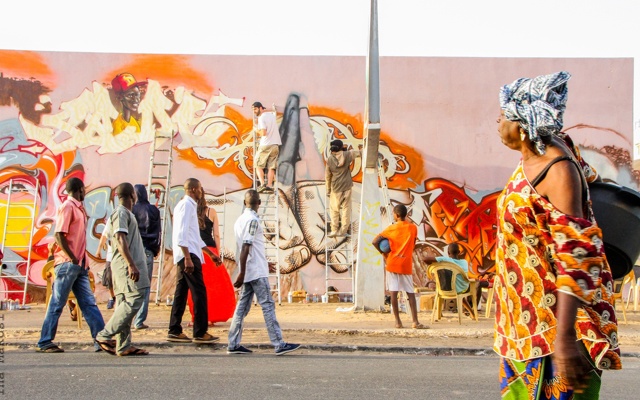One of the main cultural metropolises on the African continent where cultural activism strives. It is a scene with autonomous artists that carve their individual ways today after a period of state patronage for the arts by the poet—President Léopold Sédar Senghor. Thirty years later, the international contemporary art which gathers various practices has bloomed in the city and embraced its role as a critical tool documenting Africa and initiating fundamental debates.
In the ‘80s, I was a teenager in the capital city of Dakar. Many Senegalese children of my generation, barely knew about the Paleolithic and Neolithic wall paintings that our country had found in the River Valley. Few of us had set foot in a national museum to see tools or pottery found in the same region. None of these findings were available or given major showcases for the general public to see and appreciate. Even though back then school was the best instrument of knowledge, for the arts and culture, literature, history and savoir-vivre our pictorial training was lacking. We had never seen the Litema architectural figurines of Lesotho, mathematics at its best is practiced by rural women in the form of wall drawings and paintings. The ancestors’ practice of fractals was best evidenced in hair-braiding and traditional huts but our instruction failed to instruct us on what was ours to know. The streets of Dakar bore a few quotes of wisdom—reminders of the better beings we were supposed to be—short political statements or names of leaders, painted here and there.
Back in the ‘80s the television series Roots based on Alex Haley’s novel by the same name, had most families glued to their television sets. However Senegal’s experience with slavery was passed over quickly in class. One must go to Gorée Island to see traces of the slave trade’s history among the intense tourist activities.
Our teachers regularly boasted about the kings and princes of the fourteenth century from the Baol, Walo, Cayor, Sine, Djolof, and Saloum regions, all part of the Wolof empire. They depicted warriors yet there was no representative examples around us, with the exceptions of Lat Dior Ngoné Latyr who was considered a national hero (1842–1886). All of us were characters in the school play about the life of this man and his exploits. He battled the colonizing French in the Thiès region opposed as he was to their building a railroad to Saint-Louis in the north and he was against the peanut trade. The crop had been imposed by the French empire and then exported to metropolitan centers in Europe and America since the time of slavery. Today there are two stamps featuring Lat Dior Ngoné Latyr in celebration of his memory. The other iconic figure was Cheikh Amadou Bamba or Sëriñ Tuubaa, a religious guide, a Muslim, a Sufi and the founder of a very large and powerful brotherhood called Mouride. He founded a town in 1887, Touba, known as the holy land, that is the second largest in Senegal. He was against French colonialism too and led a long non-violent struggle. His image is present everywhere in the country and he is the most powerful role model and paradigm for the youth in Senegal.
We were told about the Arab and Berber caravans as traders, then as invaders but our history refuses that Islam was imposed on us by them. “We too have had our chosen ones, blessed by the almighty,” we were told, all our lives. In Senegal, we practice a form of Sufi rooted in brotherhood spirituality. Islam has had to negotiate its place within our traditions and customs and it is a common belief that it revealed itself through local scholars such as Cheikh Ahmabou Bamba, El Hadj Oumar Foutiyou Tall, El Hadj Malick Sy, El Hadji Ibrahima Niasse, Seydina Limamou Laye. These are characters from the past that still shape the contemporary mindset of the people of Senegal and that still exist in the youth of today’s visual expression—graffiti.
Back in the ‘80s the television series Roots based on Alex Haley’s novel by the same name, had most families glued to their television sets. However Senegal’s experience with slavery was passed over quickly in class. One must go to Gorée Island to see traces of the slave trade’s history among the intense tourist activities.
We were reminded that in 1840, Senegal became a French possession, and the people became subjects of the French Empire. Our grandfathers and fathers were colonized and had to use the saying nos ancêtres les gaulois (our ancestors, the Gallic ones) without sarcasm or else. Their colonial experience is not widely shared with the younger generation even though, just 60 years ago our nations were still colonies. On the other hand, those who fought during the First and Second World Wars are still very much in the lime light: les tirailleurs sénégalais (Senegalese riflemen); a strong colonial infantry who was sent to war against Germany and Italy. After the war, the survivors were gathered in a camp, in Thiaroye, on the outskirts of Dakar city. They demanded compensation for their war time service but after a while were left to themselves clueless as to their fate. They were massacred by the French army for asking for their back pay. The courage of these men during both wars was erased from French school programs and their pensions denied to their families until very recently after great national negotiations. The injustices done to them became the subjects of fiction (The Camp at Thiaroye by acclaimed filmmaker Ousmane Sembène and Thierno Faty Sow) major photography exhibitions, lyrics for local and diaspora musicians (Zao, Keur gui, Wa BMG 44) and a lot of television attention, until today.
It was the gathering of creative minds from poor communities that would create this powerful thing called “hip hop.”
The French language is the official language of instruction in the schools and administration. In 1960, the winds of change blew over the continent. The rumor spread and the continent claimed its sovereignty. In April 1960, Senegal is proclaimed independent with a unique political party: Union Progressiste Sénégalaise—UPS and a young Roman Catholic president named Léopold Sédar Senghor led the country. The Senegalese people were in the apprenticeship of a new political life. The president was a poet, a great literary man, who studied in France and along with Aimé Cesaire from Martinique (poet, author, and politician) created a concept called Négritude or the essence of blackness. He unfolded an official cultural ideology of the Senegalese state from 1960 to 1980. In 1966, he organized the famous World Festival of Negro Arts in Dakar under the banner "the total sum of black values." Blackness was celebrated in front of the eyes of the whole world. Those who booed the project and those who worshiped the idea of rebirth of African arts coming out of the Harlem Renaissance in the USA (where the black communities were struggling too). Africans, Caribbeans, expatriates, intellectuals, Diaspora, who believed in pan-Africanism rushed to Dakar for the event to discuss identity-resistance and the future: the contribution of the black man to world civilization.
The event was huge and popular worldwide and we were continuously told about it. The event also gave birth to the creation of The Fundamental Institute of Black Africa, the Houses of Youth and Culture, the craft village of Soumbedioune in Dakar-Senegalese wood sculpture and goldsmithing, the Dynamique Museum and the dance academy (which had been closed by then and given to the supreme court) as well as the Daniel Sorano Theater and the tapestry factory of Thiès. There was a strong sense of national identity then. The Senegalese youth began to have visuals to feed their imaginations: frescos, paintings, tapestries, music, dance, literature, and cinema. Artists had become the ambassadors of the state. In my interview with traditional dancer and choreographer Oumou Samb, the state ballet La Linguere would be on tour for two years in a row before having the opportunity to come back home to Dakar to see their families. President Senghor through state patronage had the ambition of cutting off cultural life from the colonial grip. Artists followed a vision they believed in and were paid back in turn. The business of art brought mentors like Pierre Lods, curators, gallerists, critics who accompanied the works of great artists such as Papa Ibra Tall and his tapestries, and the dance performances featuring Germaine Acogny who had been trained by the famous choreographer Maurice Béjart. The Times called “L’ecole de Dakar” (1960–1974). The Senghorian vision for the modern artist also raised resistance from younger artists who developed a critical position regarding the government’s actions. The legitimacy of the art critics then (just like curators today) and the fragility of the artists started bothering them. So new conceptual works were impulsed. The artist collective Laboratoire Agit’Art founded in 1974 by El Hadji Sy (visual arts), Issa Samb (Joe Ouakam), Djibril Diop Mambety (filmmaker), Youssoupha Dione (playwright) and others opposed the established Senghor’s cultural policy. Think tank initiatives such as Tenq, and Huit Facettes 8x7 (the artist collective that went to KASSEL DOCUMENTA in 2002), were independent multifaceted artists with great intelligence who had refused to be trapped into a single way of thinking were emerging and engaged a discourse for social change. Viyé Diba, Kan-Si, Moustapha Dimé, Guibril André Diop, Anta Germaine Gaye, Djibril N'Diaye, Cheikh Niass and others...
As much as it seems that the current generation is disconnected to all those movements or circles, their engagement with street art and popular visual culture is the continuity of a state of mind that was lingering there the whole time. In the mid- 80s these artists took art out in the streets to be seen and to interact with the locals. Tradition re-instituted as “the act of making art is a collective moment of solidarity and acceptance of the finished product,” said El Hadji Sy.
The one-sided version of history in general and of our history in particular, was being deconstructed. Wolof, one of the main local dialects became an urban patois that spread over the nation. Today the youth and the hip-hop movement have restored the language to its original place: “the center.” The Senegalese school is a prisoner of its post-colonial syllabus, language and ideology.
The artist El Hadji Sy is fan of the circus and its itinerant aspect, and having trained in a popular theater, knew that connecting with the people was crucial. He did not want to be inside. This is what every child raised in this country knows, “the penc” which means a public place, in Wolof usually at the center of the village, its where the community gathers the public space created for displays, for sharing the word, for performances, for installations. Art exhibited indoors was going back to public places in order to cohabitate with the locals. In 1994 Docta tagged a wall at a public transportation garage and complaints rose from the worried neighbors that the American and French trend of graffiti will contaminate the Senegalese youth. During a radio show, the drivers of these public transportation vehicles called and said that the graffiti had enlightened their environment and that the space was then better looked after since it had some artwork on it. No trash was thrown there and no one urinated in front of it.
These were the times we were living in. The world was coming to us through visuals, television images, radios, and from family members who were travelling abroad. We were the country that had received the whole world at the World Festival of Negro Arts. We knew what was new on the African continent, and elsewhere, what ideas were being debated. The Afro beats from Nigeria by Fela Kuti were all over, alongside those from King Sunny Ade, Prince Nico Mbarga, Osibisa from Ghana, and Rumba from Congo (formerly Zaire) with great collectives like Zaiko Langa Langa, Seigneur Tabu Ley Rochereau. We worshipped M'bilia Belle, Tchalla Muana, and Bob Marley from Jamaica, jazz and blues from the US and all kinds of music were in our ears. This music played out amid stories about dictatorships, segregation, exile, torture, political corruption, violence and oppression. So when hip hop emerged in the Bronx, it hit our generation worldwide. Hip hop’s motivation is the community, when Afrika Bambaataa, the leader of the Zulu nation, rose up out of the ghetto, he denounced the poverty of minorities in a powerful country. A country that has had a history of fighting for human rights yet still denied to Americans basic rights that were based on their race. It was the gathering of creative minds from poor communities that would create this powerful thing called “hip hop.”
Spoken word over a beat, the visual graffiti art, painting, poetry, and dance worked like an institution to defend the interest of a community. It echoed in Senegal, youth understood that it should apply this example, set a definition and perspectives, and control the game like a microcosm of the country. The community soon recognized the ability of the youth to tackle social issues and accepted that it was being led on an adventure. It all started with a campaign called “Set Setal”: a movement to cleanse the streets of a certain mentality of disengagement; of corrupt politicians. The people needed a break and the arts were already been ahead of this feeling of being fed up. The quest for a better life that was the motto of Afrika Bambaataa when he created a movement in the Bronx borough of New York in the 70s; rebellion by the arts. After all it was not new in Senegal, resistance had already begun to influence the following generation. The messages of the graffiti, the titles chosen for albums, the traditional dances mixed with urban moves, ancestral gounds or traditional clothing with modern outfits, hairstyles, all these “statements” were already political. Politics was too serious of a matter to be left to the politicians alone. The hip-hop movement in Senegal upgraded its fighting spirit by stepping out into the political arena in March 2011. The movement y’ en a marre (meaning we’ve had enough) came to life when former president Abdoulaye Wade a 90-year-old, whom the youth had voted for in droves 14 years before, decided to run for office again. The movement fought fiercely alongside the people against the decision and attracted press from around the world. The collective was composed of journalists and hip hop artists and worked as a sentinel watching out for an array of problems in the life of the Senegalese people. The constitution had regularly been retouched to give more power to the ruling party. An energy crisis deprived Senegalese homes and businesses of electricity up to 17 hours a day for six months, unemployment and precariousness was at its highest. Everybody was fed up: religious groups, elders, workers, and businesses alike. The future was a mirage. Everybody decided to disrupt the public peace, to raise awareness and spontaneously gather to address issues about the future of the country. The Senegalese citizen led by its creative youth wanted a change in governance and leadership. The world showed solidarity with us, after Tunis, Cairo, Dakar got out in the streets and responded with stones to the tear gas guns.
The 2012 Elections put Macky Sall in power. He is 54 years old today, and was the former prime minister under Abdoulaye Wade. The country cheered, the opposition went into retreat to settle its internal issues. The Senegalese youth boasted, paraded, and occupied the media as if they were warriors. Music, videos, graffiti of the takeover spread far and wide. I met the group Mizerable Graff in broad daylight, at a round about, in a middleclass neighborhood getting ready to tackle a huge brick wall. I thought, times have changed. I did not remember seeing the first graffiti collective, the Doxandem squad led by Docta, in a situation this visible. Of course today the graffiti gathering “Festi Graff” is a performance moment, the public drives by groups of international graffiti artists on ladders while the press hovers around them. But back in the 90s, artists created more discretely. Today the artists of these collectives are independent from their crews and they are invited individually by institutions or associations to transform their walls and buildings. In June 2015, Docta tagged the perimeter wall of US Ebetts field, an all-purpose sports and entertainment center in the upper-middle class neighborhood of Fenetre Mermoz. He has been invited to graffiti on the Brazilian embassy, the Dutch ambassador’s residency, the Wallonia-Brussels delegation office building that was inaugurated by the Belgian, mr Rudy Demotte, who has visited the Senegalese head of state. Docta and other visual artists were invited to create a fresco at the US embassy in Senegal, a huge, brand new 4 acres complex.
These invitations as well as international graffiti festivals have given the Senegalese youth hopes of a career through their passion for hip hop. The collective “Mizerable Graff” (Dip, BK, Diablo, Madzo) come from the generation after Docta and the Doxandem squad, and have tagged quite a few buildings too, including our art studio—Warustudio.
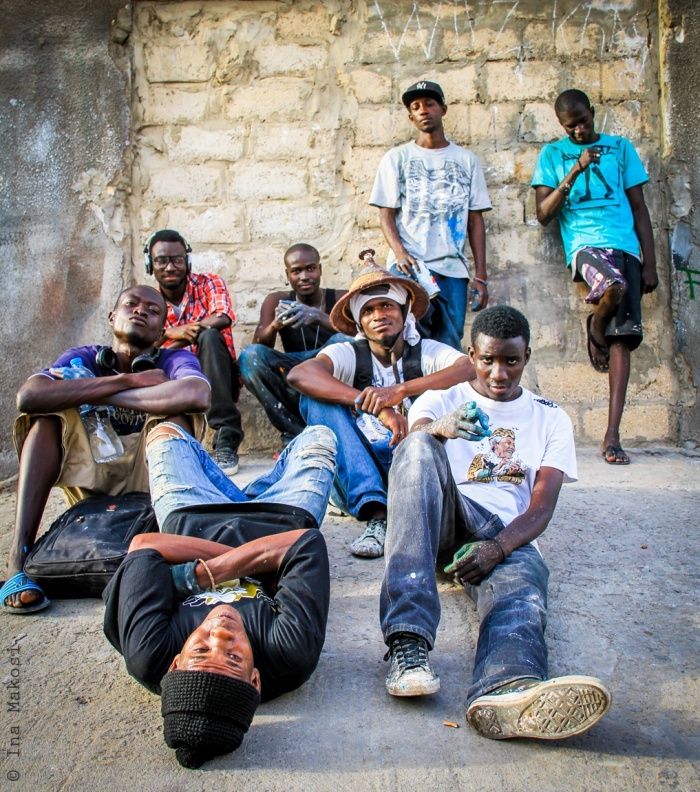
Skład RBS. Zdjęcie i prawa: Ina Thiam
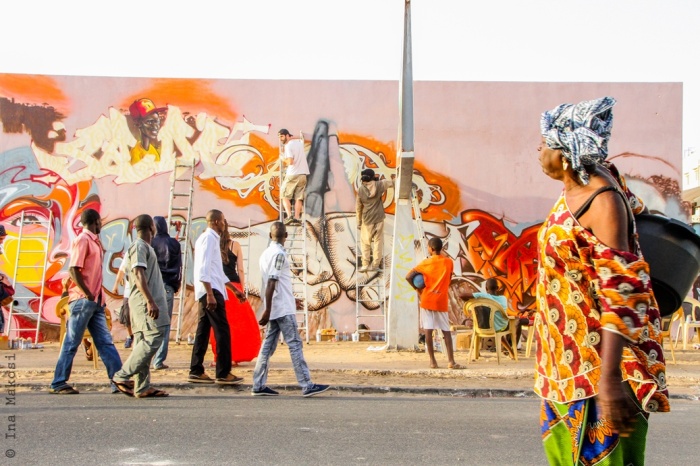
Medyna w trakcie Festi Graff, 2016. Zdjęcie i prawa: Ina Thiam
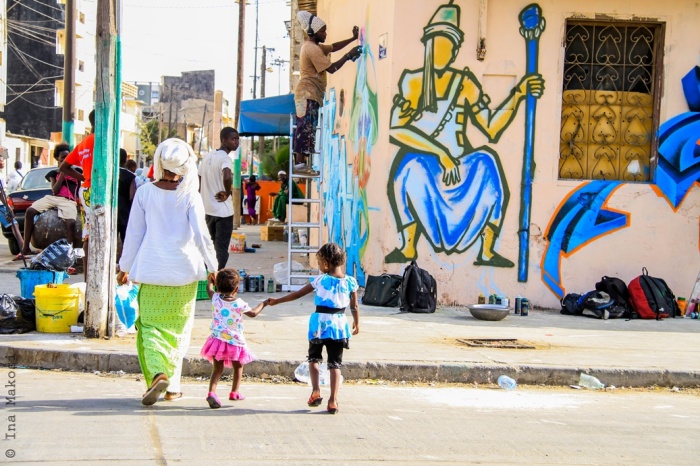
Dzielnica Medyna w trakcie festiwalu FESTA2H, 2014. Zdjęcie i prawa: Ina Thiam
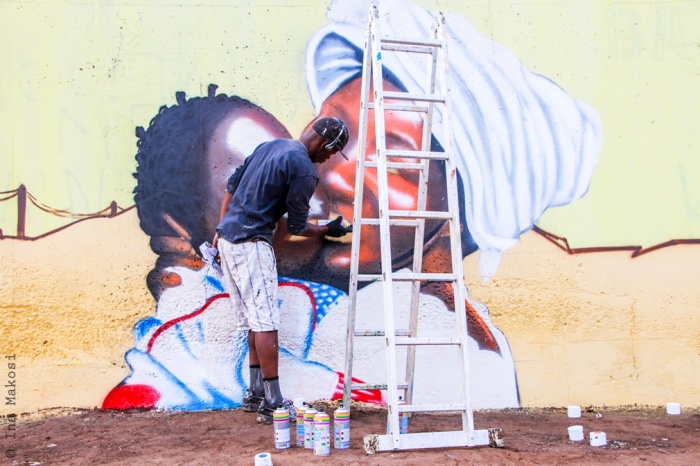
Mbautta podczas Franconnexions, 2015 Zdjęcie i prawa: Ina Thiam
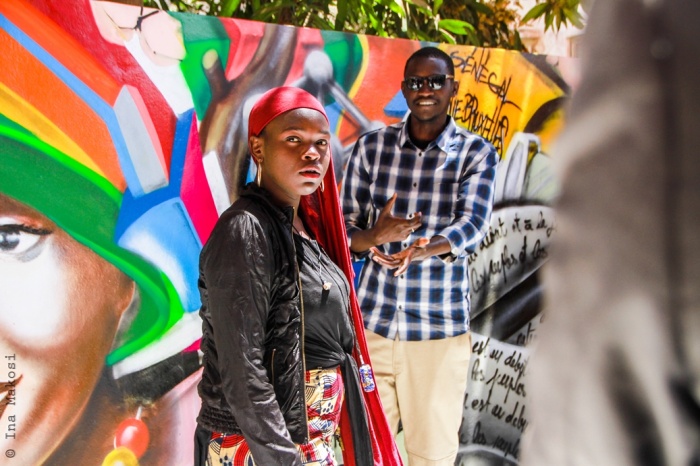
Le Duo podczas wizyty wiceprezydenta Walonii w Dakarze, 2016. Zdjęcie i prawa Ina Thiam
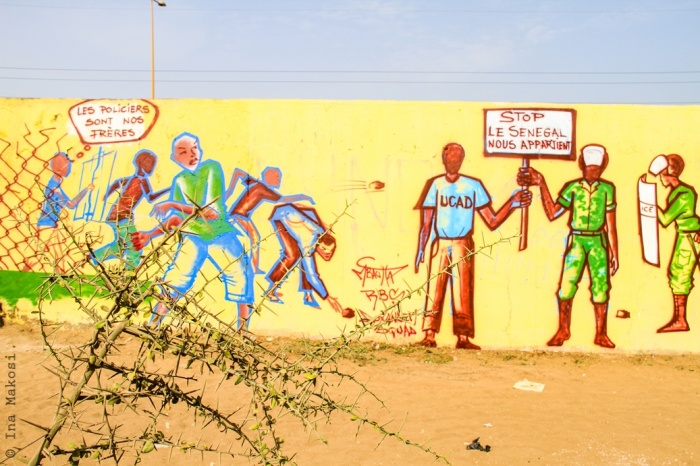
HLM, grafitti w ramach FESTA2H, 2014. Zdjęcie i prawa: Ina Thiam
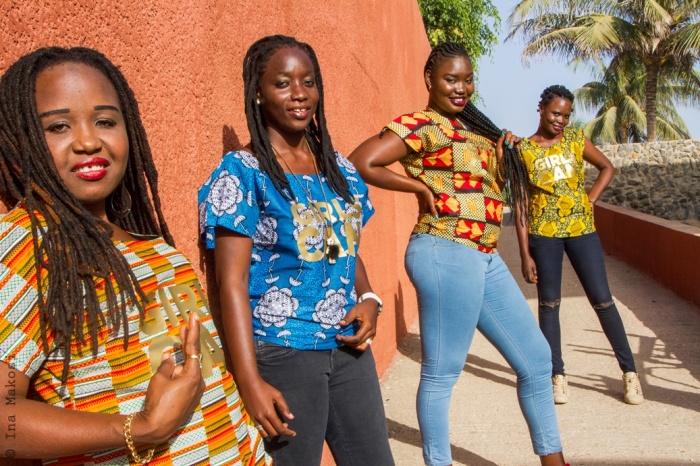
GOTAL - Girls Can. Zdjęcie i prawa: Ina Thiam

Docta w trakcie pracy, Franconnexions, 2015. Zdjęcie i prawa: Ina Thiam
Graffitti artists in Senegal have two platforms of expression. One is their natural environment where the artists graffiti t-shirts, canvas, create logos, album covers or create fashion accessories. The other platform is about social messages exposed to public criticism and this is the one they strive for. In densely populated areas like Médina famous for its interesting population mix and artistic vibrations, there is a wall at every street corner with messages about Humanity-Unity-Spirituality-Environment-Security. A lot of messages are religious, based on teachings from the religious brotherhoods. Some messages are also from revolutionary icons such as Amilcar Cabral or professor Cheikh Anta Diop. There is a famous quote from him that says we need to raise awareness amongst the elite so they educate the masses. Or the one that says that we need to use our own references to build our nations.
Younger artists are coming up in Dakar and its major cities: Eldo the Ghost, Graff in Saint Louis, Sherlock, Omar Krak, Diaz, Alpha, El Pacino, All li Guen and not to forget the ladies Zennixx, Marima and Ebène.
This year Festi Graff started on April 25 and drifted into the Dak’Art contemporary biennale (May 3rd to June 3rd), then the Saint Louis Jazz festival, the international rap festival Festa 2 H (at the end of May) and the last hip hop event YAKAAR (hope). Hip hop is organizing itself differently and showcasing its disciplines out to the world and creating its business opportunities.
Refa is an international graffiti artist from the US, he is the head of the collective Aerosol and a member of the famous black panthers. He has been coming to Senegal for a few years now, participating at the Festi Graff gatherings. The philosophy of his art practice in the US has to change in the Senegalese context. “writing” is the hardcore expression used in the US and it is still practiced with an eye on the historical context where it was born. In the late ‘60s civil rights activists were assassinated, minorities were at war in Manhattan, Brooklyn, the Bronx, and Queens; life was tough. “Writing” was a sign of protest for kids and young adults powerless in the face of the state. They covered subway cars, inside and out and intimidated the regular people quietly working for America everyday. That the youth was not going to be quiet, so the “writing” grew bigger and more colorful. Now some 45 years later, in the US, where graffiti and visual popular culture was born, and famous “writers” have spray paint colors named after them. They have invented their own colors and the market has followed. Advertising, sports companies, and others are their business partners. Who would have thought that it would have been possible back then?
The future is not an invention, it’s the sum of aspirations from the past and present. Communities have it within them in an organic way. There will be dreams of change, of different strategies and each generation will have it its own way. There will be no monopoly of what the future can be. Felwine Sarr says “societies will give birth to “something original.” We have to keep the debate open, we shall keep thinking and conversing and not deny “us.” No matter what opinion we have today of Aimé Cesaire, Léopold Sédar Senghor, Alioune Diop, Cheikh Anta Diop, Mongo Beti, Camara Laye, they have opened our eyes to a past that the youth should be aware of. The Perte et Profit, or profit and loss of some at the expense of others, on the continent after slavery, colonization, wars, globalization. All the ingredients for the future generations to help them assume control of Africa as she is at the moment, at a time when you are young, vibrant and efficient. Felwine Sarr says “Accept your historic time, deal with its contingencies, then nourish or betray it.”
Fatou Kandé Senghor
BIO
Fatou Kandé Senghor is an award-winning visual artist, documentary filmmaker and educator based in Dakar, Senegal. Her most recent film “Donner Naissance” (“Giving Birth”), a profile of enigmatic Senegalese sculptor Seni Camara, was selected for the 56th Venice Biennale. She has written widely on gender, culture, history, and African cinema, and is the founder of Waru Studio, a space for young artists and filmmakers to explore the intersection of art-science-technology and politics in Africa. Significant collaborations include working with renowned director Ousmane Sembène on Faat kiné, and with Wim Wenders on “The Invisible” (2007), a documentary on sexual violence against women in the Congo. She has just published “Wala Bok: An Oral History of Hip Hop in Senegal" (2015, Amalion Publishing) an anthology of the era-defining artists of Senegal’s hip hop movement.
*Coverphoto: District of Dakar - Medina During Festigraff Festival. Photo credits and copyright: Ina Makosi.



